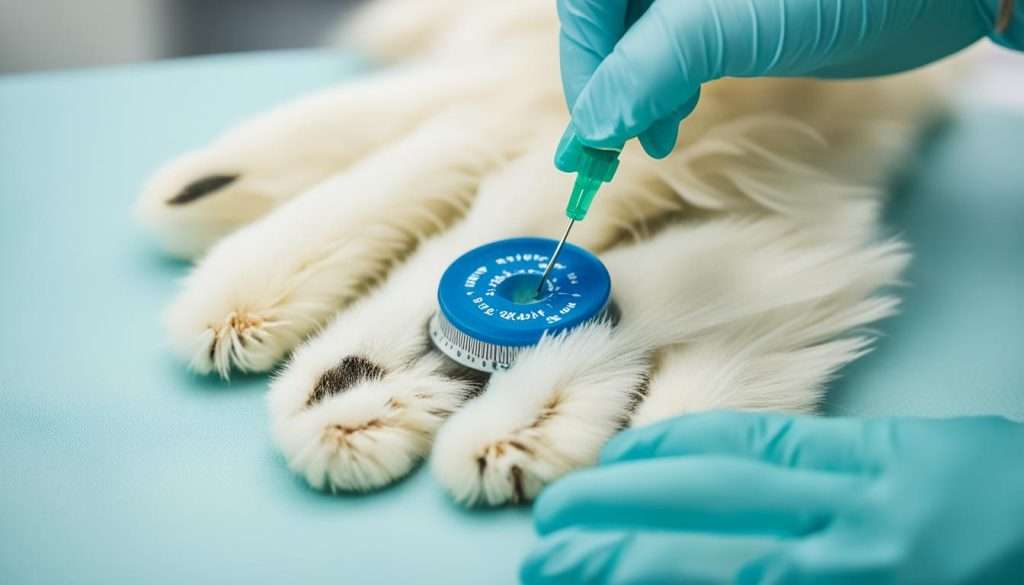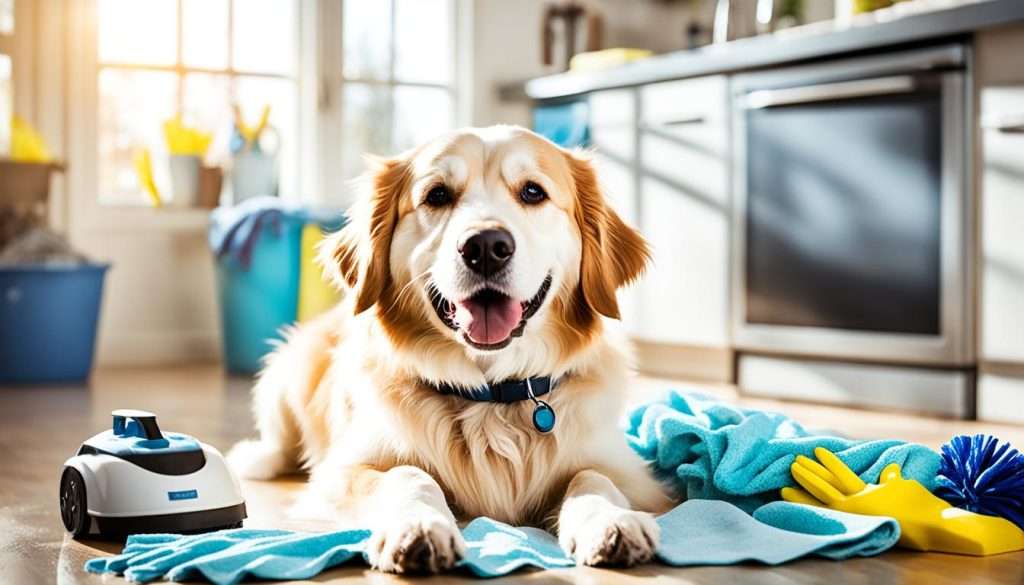If you’re a dog lover but allergic to dogs, managing your dog’s allergies can be a challenging task. Dog allergies are triggered by allergens such as dog saliva and dander, causing symptoms like sneezing, itchy eyes, and irritated skin. It’s crucial to understand dog allergies and learn how to effectively manage them to ensure your dog’s comfort and overall wellbeing.
When it comes to dog allergy management, there are several key factors to consider. Understanding the signs and symptoms of dog allergies, testing for allergens, implementing preventive measures, and seeking appropriate treatment options are essential steps in providing relief for your dog’s allergies. By following these steps, you can maintain a healthy and fulfilling relationship with your canine companion.
In this article, we will explore the various aspects of managing your dog’s allergies effectively. From recognizing the symptoms to choosing suitable breeds, we will provide insights and guidance to help you navigate through the challenges of dog allergies. Remember, seeking advice from a veterinarian is always recommended to ensure personalized and accurate information regarding your dog’s allergies.
Understanding Dog Allergies
If you notice your furry friend experiencing puffiness around the face, watery and swollen eyes, a runny nose, itching, or irritated skin, they may be suffering from dog allergies. These allergies can be triggered by allergens found in dog saliva and dander. It is essential to recognize the symptoms to determine if your dog is affected by allergies.
To provide relief for your dog’s allergies, there are several approaches you can take. Minimizing exposure to allergens is a crucial step. This can be done by keeping your dog’s living space clean and free from triggers, such as dust mites, pollen, and mold. Regular grooming, including baths, can help remove allergens from your dog’s coat and skin.
Additionally, allergy medications can be used to manage the symptoms effectively. Antihistamines can help alleviate mild symptoms, while in more severe cases, your veterinarian may prescribe topical steroids or oral corticosteroids. However, it is important to note that these medications may have potential side effects, so it’s crucial to consult with your vet regarding the appropriate treatment for your dog.
Providing your dog with relief from allergies is essential for their overall comfort and wellbeing. By understanding the symptoms, minimizing exposure to allergens, practicing regular grooming, and considering appropriate allergy treatments, you can help alleviate your dog’s allergy symptoms and improve their quality of life.
Testing for Dog Allergies
If you suspect that your dog has allergies, it’s important to get them tested to determine the specific allergens they may be allergic to. Consulting a veterinarian is the first step in identifying and managing your dog’s allergies effectively.
There are several types of tests that can be conducted to diagnose dog allergies, including:
- Skin prick tests: This test involves applying tiny amounts of common allergens to your dog’s skin and observing any allergic reactions. It helps determine the specific substances that trigger an allergic response.
- Allergen specific IgE tests: This blood test measures the levels of allergen specific IgE antibodies in your dog’s blood. Elevated levels indicate an allergy to a particular allergen.
- RAST (Radioallergosorbent) tests: Similar to IgE tests, RAST tests measure the presence of specific IgE antibodies in your dog’s blood. The results help identify the allergens responsible for triggering allergic reactions.
These tests provide valuable insights into your dog’s allergies, enabling you and your veterinarian to develop an effective allergy management plan. By determining the specific allergens your dog is allergic to, you can take appropriate measures to minimize their exposure and provide relief from allergy symptoms.
Here is an example of a table comparing different dog allergy testing methods:
| Testing Method | Description | Pros | Cons |
|---|---|---|---|
| Skin Prick Tests | Tiny amounts of allergens are applied to the skin to observe reactions. | – Provides immediate results – Identifies specific allergens |
– Requires close monitoring – May cause temporary discomfort |
| Allergen Specific IgE Tests | Blood test that measures allergen-specific IgE antibodies. | – Detects allergens in blood – Can identify allergies to multiple substances |
– Takes longer for results – May require follow-up tests |
| RAST (Radioallergosorbent) Tests | Blood test that measures specific IgE antibodies for allergens. | – Identifies allergens in blood – Provides accurate results |
– Requires blood sample – Relatively expensive |

Dealing with Dog Allergies as a Dog Owner
If you are a dog owner with allergies, there are steps you can take to manage your allergies and still enjoy the company of your furry friend.
“Minimizing contact with allergens by keeping your dog out of certain areas of the house, such as the bedroom, can help reduce symptoms.”
When it comes to preventing dog allergies, minimizing contact with allergens is key. By keeping your canine companions off the couch and out of certain areas, such as the bedroom, you can significantly decrease your exposure to allergens and minimize the risk of allergic reactions.
In addition to restricting access to specific areas, regular bathing and grooming can also help in reducing the presence of allergens on your dog’s coat and skin.
To further minimize contact with allergens, consider adopting the following practices:
- Wash your hands thoroughly after petting or playing with your dog.
- Vacuum your home frequently, focusing on areas where your dog spends the most time.
- Wash your dog’s bedding regularly using hot water to remove allergens.
Remember, while it may be challenging at times, taking these preventive measures can make a significant difference in managing your dog allergies and ensuring a harmonious relationship with your beloved pet.
With these steps in place, you can enjoy the companionship of your furry friend without compromising your health or well-being.
Dust and Clean Often
Regular cleaning is essential in reducing the presence of allergens in your home and providing relief from dog allergies. Dust and allergens can accumulate on various surfaces, so it’s crucial to establish a regular cleaning routine.
Dusting and Cleaning Tips:
- Dust and wipe surfaces throughout your home with a damp cloth or microfiber cloth to trap allergens instead of spreading them into the air.
- Pay extra attention to areas where your dog spends most of their time, such as their bedding, toys, and blankets. Clean and launder these items regularly to prevent the buildup of dander.
- Use a vacuum cleaner with a HEPA filter to effectively remove allergens from carpets, rugs, and furniture. HEPA filters are designed to capture tiny particles, including pet dander and dust mites.
- Vacuum your floors at least once a week to minimize the accumulation of allergens. Focus on high-traffic areas and areas where your dog frequently stays.
- Consider using a steam cleaner on your carpets and upholstery, as the high temperatures can help eliminate allergens.
- Wash your own bedding, curtains, and cushion covers in hot water (at least 130°F or 54°C) to kill dust mites and remove allergens.

“Regular cleaning is essential in reducing allergens and providing a more comfortable environment for both you and your dog.”
By maintaining a clean and allergen-free home, you can significantly reduce the impact of dust allergies and provide relief for dog allergy sufferers. Incorporate these cleaning practices into your routine and create a healthier living space for both you and your furry friend.
| Benefits of Regular Cleaning | Tips for Effective Cleaning |
|---|---|
|
|
Using an Air Filter
One effective way to provide relief for dog allergy symptoms and improve indoor air quality is by using an air filter. Whether you choose a portable air filter or a whole house air filter, both options can help remove allergens from the air, creating a healthier environment for you and your dog.
When selecting an air filter, it’s important to consider the type of filter used. HEPA (High-Efficiency Particulate Air) filters are considered the most effective in capturing and removing allergens such as dog dander, pollen, and dust mites. These filters can capture particles as small as 0.3 microns, ensuring that the air you breathe is clean and free from allergens.
Portable Air Filters
Portable air filters can be a great option for targeting specific areas of your home where the allergic family member spends the most time. These compact and lightweight devices can easily be moved from room to room, allowing you to create clean air zones throughout your home.
When using a portable air filter, it’s recommended to place it in the room where you or your dog spends the most time. This can be the bedroom, living room, or any other area where you both frequently occupy. By focusing the filtration on these areas, you can reduce the allergen exposure and provide much-needed relief for your dog’s allergies.
Whole House Air Filters
If you want to ensure that the air throughout your entire home is clean and allergen-free, a whole house air filter may be the best choice. These filters are installed into your HVAC system, allowing them to clean the air circulated in every room of your house.
A whole house air filter is typically more expensive than a portable option, but it offers the convenience of continuous filtration without the need to move devices from room to room. This is particularly beneficial for larger homes or if you have multiple allergy sufferers in your household.
By using a whole house air filter with a HEPA filter, you can create a healthy and comfortable living environment for both you and your dog, reducing the impact of allergies and promoting overall wellbeing.
Research Before You Buy a Dog
If you are planning to get a dog and you have known allergies, it’s important to do your research before making a decision. Some dog breeds are considered more hypoallergenic and may produce fewer allergens. Spending time with the breed you are interested in before bringing them home can help determine if you will have a reaction to that specific breed.
When choosing a suitable breed, consider the following factors:
- Allergen production: Certain dog breeds produce fewer allergens, making them more suitable for individuals with allergies. These breeds often have hair instead of fur and shed less, reducing the spread of allergens.
- Size and activity level: The size and activity level of a dog can impact the amount of dander and allergens they produce. Smaller dogs typically produce fewer allergens compared to larger breeds. Additionally, dogs with lower activity levels may result in less dander being released into the environment.
- Grooming requirements: Regular grooming can help reduce the amount of allergens present on a dog’s coat. Breeds with shorter hair or those that require frequent grooming and bathing may be more suitable for individuals with allergies.
It’s also essential to spend time with the breed you are considering to observe any allergic reactions. Visit dog shows, shelters, or contact reputable breeders to meet and interact with the dogs. This hands-on experience will give you a better understanding of how your allergies may or may not be affected by a particular breed.

Remember, every person’s allergies are unique, and what may work for one individual may not work for another. It’s crucial to consult with your allergist or healthcare provider for personalized advice before bringing a dog into your home.
Examples of Hypoallergenic Dog Breeds:
| Breed | Hypoallergenic Level | Size | Activity Level |
|---|---|---|---|
| Poodle | High | Various sizes | Moderate to high |
| Bichon Frise | High | Small | Moderate |
| Maltese | High | Toy | Moderate |
| Yorkshire Terrier | Medium | Small | Moderate |
| Shih Tzu | Medium | Small | Low to moderate |
| Portuguese Water Dog | Low | Medium to large | High |
Treating Dog Allergies
If your dog is suffering from allergies, there are various treatment options available that can provide relief and improve their quality of life. The choice of treatment depends on the severity of your dog’s allergies, and your veterinarian can recommend the most suitable option.
Antihistamines
Antihistamines are commonly used to alleviate mild symptoms of dog allergies. These medications work by blocking the histamine receptors in your dog’s body, reducing itchiness, sneezing, and other allergy symptoms. However, it’s essential to consult with your veterinarian before giving your dog any antihistamines, as some human medications are not suitable for dogs.
Topical Steroids
For small areas of skin irritation caused by dog allergies, topical steroids can be an effective treatment option. These medications can help reduce inflammation and itching. It’s crucial to follow your veterinarian’s instructions on the proper application of topical steroids, as prolonged use or overuse can lead to adverse effects.
Oral Corticosteroids
In more severe cases of dog allergies, oral corticosteroids may be prescribed. These medications work by reducing allergic reactions in the body. However, oral corticosteroids can come with potential side effects, such as increased thirst and appetite, weight gain, and increased susceptibility to infections. It’s important to discuss the risks and benefits of oral corticosteroids with your veterinarian before starting this treatment.
Remember, treating dog allergies is not a one-size-fits-all approach. Each dog is unique, and their treatment plan should be tailored to their specific needs. Regular communication with your veterinarian is essential to monitor your dog’s progress and make any necessary adjustments to their treatment plan.
Conclusion
Managing your dog’s allergies effectively is crucial to ensure their comfort and wellbeing. By understanding dog allergies, testing for allergens, implementing preventive measures, and seeking appropriate treatment, you can provide relief for your dog’s allergies and enjoy a fulfilling relationship with them. Remember to consult with a veterinarian for personalized advice and guidance in managing your dog’s allergies.
By being knowledgeable about the symptoms and triggers of dog allergies, you can take proactive steps to minimize your dog’s exposure to allergens. Regular grooming, including bathing and brushing, can help reduce dander and allergen buildup on your dog’s coat. Additionally, keeping your home clean and dust-free through regular vacuuming and using air filters can create an environment that is more comfortable for both you and your furry companion.
When it comes to treatment options, consult with your veterinarian to determine the best approach for your dog’s specific allergies. They may recommend antihistamines or topical steroids for mild symptoms, or oral corticosteroids for more severe cases. It’s important to follow their guidance and monitor your dog’s response to treatment closely.
Remember, managing your dog’s allergies is an ongoing process that requires patience and consistency. With the right knowledge and support, you can help your dog find relief from their allergies and enjoy a happier, healthier life together.
FAQ
What are the common symptoms of dog allergies?
Common symptoms of dog allergies include puffiness around the face, watery and swollen eyes, runny nose, itching, and irritated skin.
How can I provide relief for my dog’s allergies?
You can provide relief for your dog’s allergies by minimizing exposure to allergens, regular grooming, and using allergy medications as recommended by your veterinarian.
How can I test my dog for allergies?
You can consult a veterinarian to get your dog tested for allergies. Skin prick tests or allergen specific IgE (RAST) allergy tests can help determine the specific allergens your dog is allergic to.
What can I do to manage my allergies as a dog owner?
To manage your allergies as a dog owner, you can minimize contact with allergens by keeping your dog out of certain areas of the house, training your dog to stay off the couch, and regularly bathing and grooming your dog.
How can I reduce the presence of allergens in my home?
Regular dusting and cleaning, including washing your dog’s bedding and toys, using a vacuum cleaner with a HEPA filter, and washing your own bedding and curtains in hot water, can help reduce the presence of allergens in your home.
Should I consider using an air filter to help with dog allergies?
Yes, using an air filter can help remove allergens from the air and improve indoor air quality. HEPA filters are considered the most effective type of filters for removing allergens.
Are there hypoallergenic dog breeds that are suitable for people with allergies?
Yes, some dog breeds are considered more hypoallergenic and may produce fewer allergens. Researching and spending time with the breed you are interested in before bringing them home can help determine if you will have a reaction to that specific breed.
What treatment options are available for managing dog allergies?
Treatment options for managing dog allergies include antihistamines to alleviate mild symptoms, topical steroids for small areas of irritation, and oral corticosteroids in more severe cases. Your veterinarian can recommend the most suitable treatment option based on the severity of your dog’s allergies.